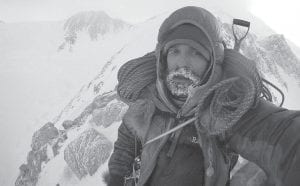The fourth time was the charm for intrepid arctic explorer and adventurer Lonnie Dupre who summited Denali on January 11, making him the first person to solo climb the 20,237-foot mountain in January, the coldest, darkest month of the year. As of press time Lonnie was still awaiting a plane to fly him back to his base of operations in Talkeetna, Alaska.

When he arrived at the top of North America Lonnie Dupre didn’t dance a jig, didn’t sing a little song, didn’t think anything big or small or profound. He just stood there and thought, “I made it.”
Dupre stood on top of Mount Denali for a brief time, only the soft glow of the moon washing over him, a thousand stars at his fingertips, a dream accomplished, then he carefully headed down to where the oxygen wasn’t so rare, peaceful but triumphant.
On his fourth winter attempt Grand Marais arctic adventurer Lonnie Dupre became the first man to solo summit Denali, (aka Mount McKinley) in January, finishing his climb to the top on Sunday, January 11 at 5 p.m. central time.
Dupre had arrived at his base camp on December 18 and began his 25-day venture up the rugged mountain. At the lower stages he pulled a 5-foot sled loaded with 160 pounds of gear. At higher elevations when the climb got steeper, Dupre switched to carrying gear and supplies in stages in his backpack. He marked his path up the incline carefully with bamboo wands, placing them near crevasses and marking his camps.
Along the way he said he fought loneliness and the darkness that prevails Alaska’s winters caused him some depression. It is dark 18 out of 24 hours in January.
At 20,237 feet above sea level, Denali, which means “The High One” in the Koyukon Athabasken language, is North America’s highest mountain peak. In 1952 Denali was measured at 20,320 feet, but more recent measurements have scaled its height down a bit. Two thermometers have recorded temperatures of -100° F; one in 1913 and one placed by the U.S. Army in 1950 at 15,000 feet that was retrieved in 1969 that also recorded a temperature of -100 F.
Five glaciers call Denali home. On the northwest side lies Peters Glacier; on the east side sits the Muldrow Glacier while the Tralekia Glacier abuts the eastern side of the mastiff. Ruth Glacier lies to the southeast side and the Kahlitna Glacier leads up the southwest side of the mountain which is the route taken by Dupre.
Throughout the years these glaciers have shrunk, and Dupre has used his climbs to bring attention to the effects climate change has had on them.
Denali in the winter is beautiful, majestic and magical when draped with snow and caught in sunlight, but it can be a beast when temperatures dip below -60° F and winds exceed 100 mph.
Twice Dupre had to go back down the mountain because of bad weather which trapped him in tiny snow caves for seven days only eight hours from the peak. His second attempt he also had to go back down when high winds and cold temperatures drove him off the mountain when he got to 14,200 feet.
Only a team of three Russians have made the summit in January, and only nine expeditions totaling 16 people have reached the mountain top in winter, with six deaths occurring, most of those happening on the way down.
“I spent a lot of time this past year trying to figure out how to inspire folks about the need to do something about climate change,” said Dupre. “So, we have made our film called Cold Love, which is about Arctic adventure and the world’s need—people’s need—for snow and ice. Snow and ice are important in our polar regions because they help reflect the sun’s energy back into space. Basically, the planet’s polar regions act as a thermostat to keep our planet cool.”
On January 13 he was at his base camp on the Kahlitna glacier at 7,200 feet. He made a meal of rice pudding and camp chow and drank some tea. He talked about arriving in Talkeetna the next day. He said he wanted to eat fresh salad, eat fresh fruit, take a long hot shower then drink a beer or sip a glass of wine. And rest. Unfortunately two planes that went to pick him and his gear up on the 14th had to turn back because of bad weather. A second attempt was made on the 15th. As of press time Lonnie was still waiting for a flight to Talkeetna, talking about fresh food and taking a warm shower. After 29 days of snow and ice, even the most intrepid arctic adventurer and protector of Polar Regions needed to rest and finally warm up.


Loading Comments